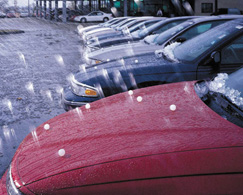Thunderstorms this year have battered the U.S. as never before, forcing businesses and insurers to grapple with record-setting levels of damage more typically found with hurricanes.
A Pfizer drug manufacturing plant in North Carolina was extensively damaged by a tornado in July. So was a Georgia facility owned by cabinet maker MasterBrand in January and a Wyoming coal mine owned by Peabody Energy in June. Dozens were injured when a storm pelted a Colorado music venue with golf-ball sized hail, also in June, while a September hailstorm near Austin, Texas, damaged 750 vehicles owned by auto dealership operator Penske Automotive Group.
The weather events, formally known as severe convective storms, have so far led to at least $55.67 billion in insured damage in the U.S. this year through Nov. 13, according to data from reinsurance company Gallagher Re. Insured damages from the storms had never before topped $50 billion.
The onslaught of severe weather has forced businesses to adopt various strategies as they try to cope.
“Severe weather has been on the uptick,” said Victor Rodriguez, who Amazon hired in 2022 to serve as its first chief meteorologist. “You’re seeing a lot of companies in the industry that are hiring meteorologists, that may not have before.”
Severe enough weather can result in facilities being temporarily closed, said Rodriguez, who previously served as meteorologist in the U.S. Marine Corps. At Amazon, Rodriguez helps the company prepare for weather challenges, both long-term and short.
In March, for example, days ahead of what turned out to be an event involving dozens of tornadoes touching down in the Central Plains, Rodriguez helped operations managers with their weather preparations, including rerouting vehicles.
The weather is also impacting insurance. Businesses seeking coverage are struggling as carriers have moved to insulate themselves from the losses.
“Risk managers across all industries are having to talk with their boards to say insurance is really expensive right now,” said Penni Chambers, vice president of risk management for real-estate developer Hillwood. “The boards are having to just essentially take it on the chin.”
Chambers said insurers are forcing businesses to accept policies with large deductibles for hail damage.
“We’ve had very little ability to push back,” said Chambers, who also serves as a board member of the risk management society RIMS.
In U.S. weather history, hurricanes have been the catastrophes most associated with outsize human and financial costs. Insurance companies dub them “primary perils” and intensely model them. Hurricane names—Katrina, Sandy, Ian, Maria—can resonate for years after the storm has passed.
Though severe convective storms appear and disappear fast when compared with the dramatic evolution of a hurricane, their aggregate damages stack up, so far this year accounting for about two-thirds of all insured natural hazard-related losses, according to Gallagher Re.
As the U.S. economy grows and settlements sprawl into the countryside, there are more built-up areas that can be pummeled with storms, a phenomenon known as an “expanding bull’s-eye.”
“The potential damage footprint is growing,” said Steven Bowen, chief science officer at Gallagher Re. “There’s more stuff that’s in harm’s way.”
More than 80% of the increased loss from convective storms is driven by growth in what insurers call exposure, which comes from things like population growing and spreading out, as well as inflation in construction costs leading to higher rebuilding costs, said a study from professional services firm Aon.
Strong economic growth is coincidentally occurring in regions of the U.S. often subject to strong storms, such as Texas.
Most U.S. SCS-related damage comes from hail, Gallagher Re said. In the U.S., there have been more than a thousand reported hail storms that involved hailstones at least two inches in diameter, the second highest figure on record.
“These secondary perils are kind of analogous to death by 1,000 cuts,” said Louis Gritzo, chief science officer at commercial insurer FM Global. “You’re having a hailstorm here and another one there and windstorm here and flood. And they’re just adding up.”
The role of climate change in potentially changing the patterns around convective storms isn’t as well understood as is climate change’s impact on other weather events. But warmer air generally speaking can hold more water, which can contribute to wetter storms.
“In a warming environment, there’s more holding capacity of water in that air, and when it rains, the rainfall rates are getting more intense,” said Gritzo.
Some businesses are turning toward parametric policies, a type of coverage that pays in response to specific weather events and with a less intense adjustment process, Hillwood’s Chambers said. Many are also grappling to find measures they can take to deal with the relative unpredictability of convective storms.
“When it comes to hurricanes, you have three days to get out of Dodge and you have some preparation [time],” she said. “Tornadoes don’t give you preparation, and neither do hailstones.”














